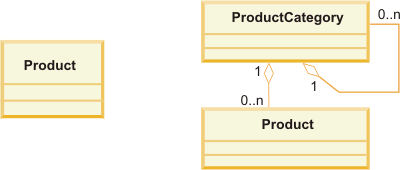IBM BPM, V8.0.1, All platforms > Programming IBM BPM > Business objects programming > Programming model > Modeling business objects
Flat and hierarchical business objects
Business objects can be modeled as flat or as hierarchical.
Flat business object
A flat business object contains one or more simple attributes and a list of supported verbs. A simple attribute represents one value, such as a String or Integer or Date. All simple attributes have single cardinality. If the business object is an application-specific business object, a flat business object can represent one entity in an application or in a technology standard.
Hierarchical business object
Hierarchical business object definitions define the structure of multiple related entities, encapsulating not only each individual entity but also aspects of the relationship between entities. In addition to containing at least one simple attribute, a hierarchical business object has one or more attributes that are complex (that is, the attribute itself contains one or more business objects, called child business objects). The business object that contains the complex attribute is called the parent business object.
There are two types of relationships between parent and child business objects:
- Single cardinality - When an attribute in a parent business object represents a single child business object. The type of the attribute is set to the name of the child business object, and the cardinality is set to one.
- Multiple cardinality - When an attribute in the parent business object represents an array of child business objects. The type of the attribute is set to the name of the child business object, and the cardinality is set to n.
In turn, each child business object can contain attributes that contain a child business object, or an array of business objects, and so on. The business object at the top of the hierarchy, which itself does not have a parent, is called the top-level business object. Any single business object, independent of its child business objects that it might contain (or that might contain it), is called an individual business object.
Example
The following example helps illustrate the difference between a flat business object and hierarchical business object. The diagram contains a flat business object, named Product. The business object is represented in memory with the Service Data Object type commonj.sdo.DataObject (unless it was statically generated). This flat business object has a set of attributes that are modeled as XML schema simple types as well as an attribute that is modeled as a list of simple types.
The diagram also illustrates a Product business object, in combination with the ProductCategory business object, to create a more complex hierarchical business object. This business object has both a top-level business object (ProductCategory), as well as a contained business object (Product).
Figure 1. Comparison of flat and hierarchical business objects

Here is example of the flat business object definition for the Product business object. The Product business object defines two properties, Name and Inventory, that are typed by the XML schema simple types xs:string and xs:int. In addition, Product also demonstrates the definition of List property Color, which is a List of xs:string simple types.
<schema> targetNamespace="http://www.scm.com/ProductTypes" xmlns:xs="http://www.w3.org/2001/XMLSchema" xmlns="http://www.w3.org/2001/XMLSchema"> <complexType name="Product"> <sequence> <element name="name" type="string"/> <element name="inventory" type="int"/> <element name="color" type="string" maxOccurs="unbounded"/> </sequence> </complexType> </schema>
Here is example of the hierarchical business object ProductCategory. The definition defines two different business objects, ProductCategory and Product. The hierarchical ProductCategory business object defines the property, Name and also defines a List of business objects of type Product or ProductCategory.
<schema> targetNamespace="http://www.scm.com/ProductCategoryTypes" xmlns:pc="http://www.scm.com/ProductCategoryTypes" xmlns:xs="http://www.w3.org/2001/XMLSchema" xmlns="http://www.w3.org/2001/XMLSchema"> elementFormDefault="qualified"> <complexType name="ProductCategory"> <sequence> <element name="name" type="string"/> <choice> <element name=="productCategory" type="pc:ProductCategory" maxOccurs="unbounded"/> <element name=="product" type="pc:Product" maxOccurs="unbounded"/> </choice> </sequence> </complexType> <complexType name="Product"> <sequence> <element name="name" type="string"/> <element name=="inventory" type="int"/> <element name=="color" type="string" maxOccurs="unbounded"/> </sequence> </complexType> </schema>